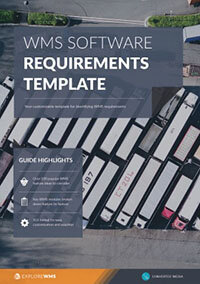WMS requirements gathering in five simple steps
You think your business needs a new warehouse management system. Why? Before going any further, get your team together and give that simple question some thought. It's time to launch your WMS requirements gathering exercise.
1. Understand why you are considering this change
Was there an evolution where your needs moved beyond your capability to manage and meet those needs? Alternatively, was there a more sudden change, such as a major customer saying they would not continue doing business unless you upgraded your capabilities?
Document your reasons carefully. Aim for unanimous agreement among all key stakeholders that the best way to manage these changes is through purchasing a new WMS.
2. Gain support from senior management
Does top management agree with the need to improve your WMS? You could be ready to launch your project immediately if at least one of your executive managers is already a member of your discussion team. If not, get one or more executive sponsor on your side before going any further. If you cannot get an executive sponsor who will actively support the WMS, now is the time to place this idea on the back burner.
3. Add details to your WMS requirements
The answer to the ‘why’ question will be first on the list. You might have several answers to the question of why you need a new WMS. If so, list all of them. Keep inquiring among your management team and add more to the list - you will find there are improvements that are strongly needed but weren’t enough to push anyone into action.
Use this WMS requirements template to get detailed feature ideas and shortlist vendors
Gather key WMS requirements from each department that are impossible or difficult to meet with your current systems. Ask throughout your enterprise where there are needs. Limiting your inquiry to management only will overlook user needs everywhere – you might find that someone spends an entire day each week collecting data from several resources that could be completed in minutes through system improvements, for example.
4. Include the numbers
How much money does the company currently spend that might be saved if there were a new WMS? Can the rate of fulfillment per hour be improved with system improvements? What supply chain factors can be changed? Can end-of-period financial reports be prepared more quickly or more accurately? You will need this quantitative analysis when you need to establish a return on your investment later on, as a new WMS will likely cost a lot of money.
5. Rank your needs
Look over each WMS requirement and divide them into two lists. The first are requirements that absolutely must be addressed through the WMS. The second are 'nice to have' improvements that will pay off but you could continue to manage without these. Rank each requirement within both buckets. As you later compare different systems, these will be the factors that separate those systems.
Free white paper

WMS requirements template
Over 120 WMS feature ideas to help you build a requirements list and shortlist vendors

Featured white papers
-

WMS requirements template
Over 120 WMS feature ideas to help you build a requirements list and shortlist vendors
Download
Related articles
-

Your complete WMS features and requirements guide
How to gather requirements for a new WMS, and features to look for to meet them
-

Mission-critical features of food lot traceability software
What features of food traceability software will help you during a food recall
-

Here's your complete WMS modules and features checklist
All the features and modules you might need in your WMS - perfect for requirements gathering

